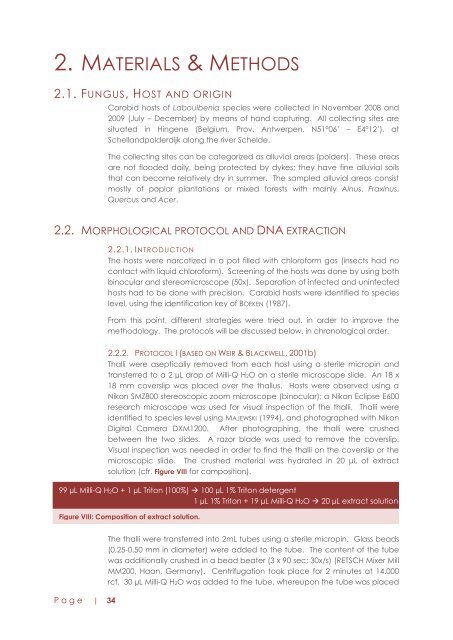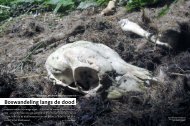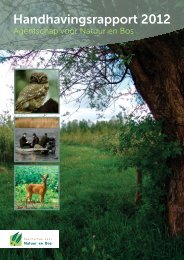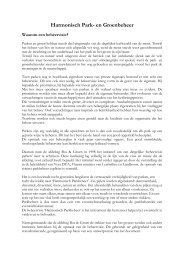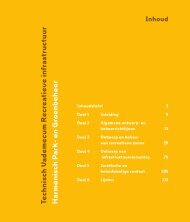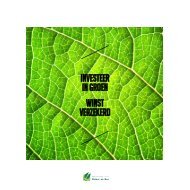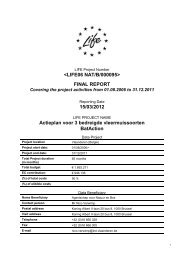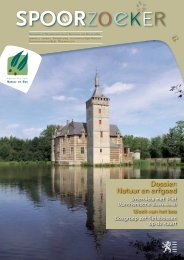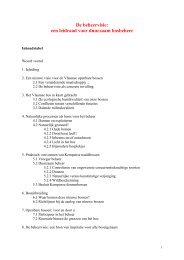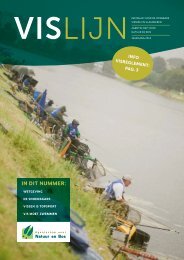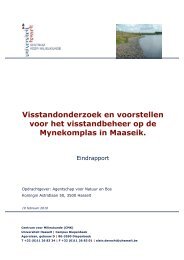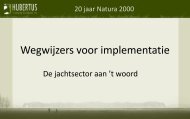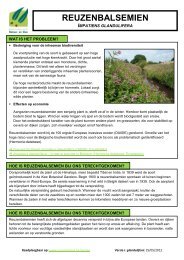LABOULBENIALES - Agentschap voor Natuur en Bos
LABOULBENIALES - Agentschap voor Natuur en Bos
LABOULBENIALES - Agentschap voor Natuur en Bos
You also want an ePaper? Increase the reach of your titles
YUMPU automatically turns print PDFs into web optimized ePapers that Google loves.
2. MATERIALS & METHODS2.1. FUNGUS, HOST AND ORIGINCarabid hosts of Laboulb<strong>en</strong>ia species were collected in November 2008 and2009 (July – December) by means of hand capturing. All collecting sites aresituated in Hing<strong>en</strong>e (Belgium, Prov. Antwerp<strong>en</strong>, N51°06‟ – E4°12‟), atSchellandpolderdijk along the river Schelde.The collecting sites can be categorized as alluvial areas (polders). These areasare not flooded daily, being protected by dykes; they have fine alluvial soilsthat can become relatively dry in summer. The sampled alluvial areas consistmostly of poplar plantations or mixed forests with mainly Alnus, Fraxinus,Quercus and Acer.2.2. MORPHOLOGICAL PROTOCOL AND DNA EXTRACTION2.2.1. INTRODUCTIONThe hosts were narcotized in a pot filled with chloroform gas (insects had nocontact with liquid chloroform). Scre<strong>en</strong>ing of the hosts was done by using bothbinocular and stereomicroscope (50x). Separation of infected and uninfectedhosts had to be done with precision. Carabid hosts were id<strong>en</strong>tified to specieslevel, using the id<strong>en</strong>tification key of BOEKEN (1987).From this point, differ<strong>en</strong>t strategies were tried out, in order to improve themethodology. The protocols will be discussed below, in chronological order.2.2.2. PROTOCOL I (BASED ON WEIR & BLACKWELL, 2001b)Thalli were aseptically removed from each host using a sterile micropin andtransferred to a 2 µL drop of Milli-Q H2O on a sterile microscope slide. An 18 x18 mm coverslip was placed over the thallus. Hosts were observed using aNikon SMZ800 stereoscopic zoom microscope (binocular); a Nikon Eclipse E600research microscope was used for visual inspection of the thalli. Thalli wereid<strong>en</strong>tified to species level using MAJEWSKI (1994), and photographed with NikonDigital Camera DXM1200. After photographing, the thalli were crushedbetwe<strong>en</strong> the two slides. A razor blade was used to remove the coverslip.Visual inspection was needed in order to find the thalli on the coverslip or themicroscopic slide. The crushed material was hydrated in 20 μL of extractsolution (cfr. Figure VIII for composition).99 µL Milli-Q H2O + 1 µL Triton (100%) 100 µL 1% Triton deterg<strong>en</strong>t1 µL 1% Triton + 19 µL Milli-Q H2O 20 µL extract solutionFigure VIII: Composition of extract solution.P a g e | 34The thalli were transferred into 2mL tubes using a sterile micropin. Glass beads(0,25-0,50 mm in diameter) were added to the tube. The cont<strong>en</strong>t of the tubewas additionally crushed in a bead beater (3 x 90 sec; 30x/s) (RETSCH Mixer MillMM200, Haan, Germany). C<strong>en</strong>trifugation took place for 2 minutes at 14.000rcf. 30 µL Milli-Q H2O was added to the tube, whereupon the tube was placed


